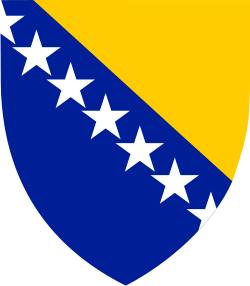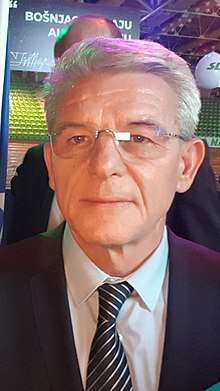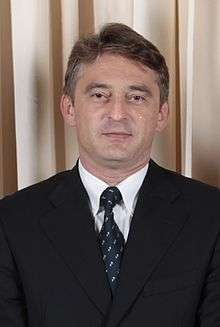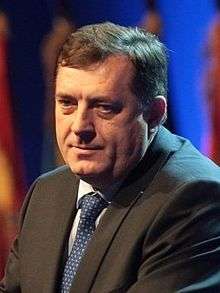Presidency of Bosnia and Herzegovina
 |
|---|
| This article is part of a series on the politics and government of Bosnia and Herzegovina |
|
Recent elections |
|
The Presidency of Bosnia and Herzegovina is the three-member body which collectively serves as head of state of Bosnia and Herzegovina.[1]
According to the Article V of the Constitution of Bosnia and Herzegovina, the Presidency of Bosnia and Herzegovina consists of three members: one Bosniak and one Croat elected from the Federation and one Serb elected from the Republika Srpska.[2] Together, they serve one four-year term.[3]
The member with the most votes becomes the chairperson unless he or she was the incumbent chairman at the time of the election, but the chairmanship rotates every eight months, to ensure equality.
Current members
| Member of Presidency | Joined Presidency | Party | Representing | Chairman term | ||
|---|---|---|---|---|---|---|
| Bakir Izetbegović |  |
10 November 2010 2nd term |
SDA | Bosniaks | 10 March 2012 – 10 November 2012 10 March 2014 – 17 November 2014 17 March 2016 – 17 November 2016 17 March 2018 – present | |
| Dragan Čović |  |
17 November 2014 2nd term |
HDZ BiH | Croats | 2 April 2003 – 10 April 2003 27 June 2003 – 28 February 2004 17 July 2015 – 17 March 2016 17 July 2017 – 17 March 2018 | |
| Mladen Ivanić |  |
17 November 2014 1st term |
PDP | Serbs | 17 November 2014 – 17 July 2015 17 November 2016 – 17 July 2017 | |
Elected members
| Member of Presidency-elect | Joining Presidency | Party | Representing | Chairman term | ||
|---|---|---|---|---|---|---|
| Šefik Džaferović |  |
November 2018 1st term |
SDA | Bosniaks | ||
| Željko Komšić |  |
November 2018 3rd term |
DF | Croats | 6 July 2007 – 6 March 2008 6 July 2009 – 6 March 2010 10 July 2011 – 10 March 2012 10 July 2013 – 10 March 2014 | |
| Milorad Dodik |  |
November 2018 1st term |
SNSD | Serbs | ||
Powers, duties and responsibilities
The Presidency is responsible for:
- Conducting the foreign policy of Bosnia and Herzegovina;
- Appointing ambassadors and other international representatives, no more than two thirds of which may come from the Federation;
- Representing Bosnia and Herzegovina in European and international organizations and institutions and seeking membership in such organizations and institutions of which it is not a member;
- Negotiating, denouncing, and, with the consent of the Parliamentary Assembly, ratifying treaties of Bosnia and Herzegovina;
- Executing decisions of the Parliamentary Assembly;
- Proposing, upon the recommendation of the Council of Ministers, an annual budget to the Parliamentary Assembly;
- Reporting as requested, but no less than annually, to the Parliamentary Assembly on expenditures by the Presidency;
- Coordinating as necessary with international and nongovernmental organizations in Bosnia and Herzegovina, and;
- Performing such other functions as may be necessary to carry out its duties, as may be assigned to it by the Parliamentary Assembly, or as may be agreed by the Entities.
Members of Presidency
More than 95% of population of Bosnia and Herzegovina belongs to one of its three constituent nations: Bosniaks, Serbs and Croats. According to the Constitution, the Presidency consists of three members: one Bosniak and one Croat elected from the Federation and one Serb elected from the Republika Srpska.
List of Bosniak members
- Fikret Abdić (1 March 1992 – 20 October 1993)
- Alija Izetbegović (1 March 1992 – 14 October 2000)
- Nijaz Duraković (20 October 1993 – 5 October 1996)
- Halid Genjac (14 October 2000 – 30 March 2001)
- Beriz Belkić (30 March 2001 – 28 October 2002)
- Sulejman Tihić (28 October 2002 – 6 November 2006)
- Haris Silajdžić (6 November 2006 – 10 November 2010)
- Bakir Izetbegović (10 November 2010 – Incumbent)
- Šefik Džaferović (Elect) (November 2018)
List of Croat members
- Stjepan Kljujić (1 March 1992 – 9 November 1992) (1st term)
- Franjo Boras (1 March 1992 – 20 October 1993)
- Miro Lasić (24 December 1992 – 20 October 1993)
- Stjepan Kljujić (20 October 1993 – 5 October 1996) (2nd term)
- Ivo Komšić (20 October 1993 – 5 October 1996)
- Krešimir Zubak (5 October 1996 – 13 October 1998)
- Ante Jelavić (13 October 1998 – 7 March 2001)
- Jozo Križanović (28 March 2001 – 28 October 2002)
- Dragan Čović (28 October 2002 – 29 March 2005) (1st term)
- Ivo Miro Jović (9 May 2005 – 6 November 2006)
- Željko Komšić (6 November 2006 – 17 November 2014) (1st term)
- Dragan Čović (17 November 2014 – Incumbent) (2nd term)
- Željko Komšić (Elect) (November 2018) (2nd term)
List of Serb members
- Biljana Plavšić (1 March 1992 – 9 April 1992)
- Nikola Koljević (1 March 1992 – 9 April 1992)
- Nenad Kecmanović (17 June 1992 – 6 July 1992)
- Mirko Pejanović (17 June 1992 – 5 October 1996)
- Tatjana Ljujić-Mijatović (24 December 1992 – 5 October 1996)
- Momčilo Krajišnik (5 October 1996 – 13 October 1998)
- Živko Radišić (13 October 1998 – 28 October 2002)
- Mirko Šarović (28 October 2002 – 2 April 2003)
- Borislav Paravac (10 April 2003 – 6 November 2006)
- Nebojša Radmanović (6 November 2006 – 17 November 2014)
- Mladen Ivanić (17 November 2014 – Incumbent)
- Milorad Dodik (Elect) (November 2018)
List of members from other ethnicities (1992–1996)
1. Ejup Ganić (1 March 1992 – 5 October 1996) - representing Yugoslavs
List of additional members during a state of imminent peril (Bosnian War) (1992–1995)
- Speakers of the Parliamentary Assembly:
1. Momčilo Krajišnik (8 April 1992 – 14 September 1992) 2. Mariofil Ljubić (14 September 1992 – 25 December 1992) - as Deputy Speaker 3. Miro Lazović (25 December 1992 – 22 December 1995)
1. Jure Pelivan (8 April 1992 – 9 November 1992) 2. Mile Akmadžić (9 November 1992 – 25 October 1993) 3. Haris Silajdžić (25 October 1993 – 22 December 1995)
- Commander of the Territorial Defence Force (TORBIH):
1. Hasan Efendić (8 April 1992 – 25 May 1992)
- Commander of the Main Staff of Territorial Defence Force (TORBIH):
1. Sefer Halilović (25 May 1992 – 8 June 1993)
- Commander of the Main Staff of the Army of the Republic of Bosnia and Herzegovina (ARBiH):
1. Rasim Delić (8 June 1993 – 22 December 1995)
History and period before elections (1945–1992)
Heads of State of SR Bosnia and Herzegovina
Presidency of the early Republic of Bosnia and Herzegovina
When the country declared independence in 1992, the Presidency consisted of:
- two Bosniak members - Alija Izetbegović and Fikret Abdić
- two Serb members - Biljana Plavšić and Nikola Koljević
- two Croat members - Stjepan Kljujić and Franjo Boras
- one other member - Ejup Ganić
Over the course of the Bosnian War, the Presidency underwent several changes: the Serb members Plavšić and Koljević, as well as the Croat member Boras, left the Presidency early on and were replaced by Nenad Kecmanović, Mirko Pejanović and Ivo Komšić, respectively. Kecmanović soon also left, and was replaced by Tatjana Ljujić-Mijatović. After a while, Abdić was replaced with Nijaz Duraković.
Presidency elections
Presidency elected in 1996
Elected members:
- Alija Izetbegović for the Bosniaks
- Momčilo Krajišnik for the Serbs
- Krešimir Zubak for the Croats
Presidency elected in 1998
Elected members:
- Alija Izetbegović for the Bosniaks, since 5 October 1996 (chairman between 14 February and 14 October 2000)
- Živko Radišić for the Serbs, since 13 October 1998
- Ante Jelavić for the Croats, September 1998 to March 2001
Živko Radišić with 52% of the Serb vote was elected chairman of the collective presidency for the first 8 months; Ante Jelavić with 52% of the Croat vote followed Radišić in the rotation; Alija Izetbegović with 87% of the Bosniak vote won the highest number of votes in the election but was ineligible to serve a second term until Radišić and Jelavić had each served a first term as Chairman of the Presidency. Ante Jelavić was replaced by Jozo Križanović for the remainder of his term based on a decision issued by Wolfgang Petritsch, High Representative for Bosnia and Herzegovina.
Presidency elected in 2002
Elected members:
- Dragan Čović for the Croats
- Mirko Šarović for the Serbs
- Sulejman Tihić for the Bosniaks
Mirko Šarović with 35.5% of the Serb vote was elected chairman of the collective presidency for the first eight months; Dragan Čović received 61.5% of the Croat vote; Sulejman Tihić received 37% of the Bosniak vote.
Mirko Šarović resigned in 2003 due to his implication in the scandal regarding the selling of arms to Iraq. The Parliament replaced him with Borislav Paravac.
Dragan Čović was dismissed by the High Representative Paddy Ashdown, after Čović was indicted for financial corruption; however, the trial hasn't taken place yet. The Parliament replaced him with Ivo Miro Jović.
Presidency elected in 2006
Elected members:
- Željko Komšić for the Croats
- Nebojša Radmanović for the Serbs
- Haris Silajdžić for the Bosniaks
Presidency elected in 2010
Elected members:
- Željko Komšić for the Croats
- Nebojša Radmanović for the Serbs
- Bakir Izetbegović for the Bosniaks
Presidency elected in 2014
Elected members:
- Dragan Čović for the Croats
- Mladen Ivanić for the Serbs
- Bakir Izetbegović for the Bosniaks
Presidency elected in 2018
Elected members:
- Željko Komšić for the Croats
- Milorad Dodik for the Serbs
- Šefik Džaferović for the Bosniaks